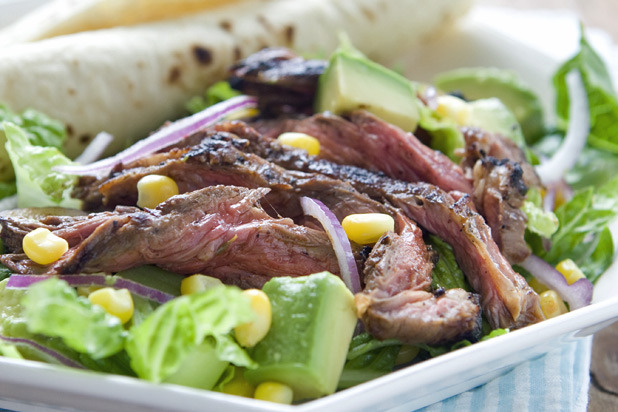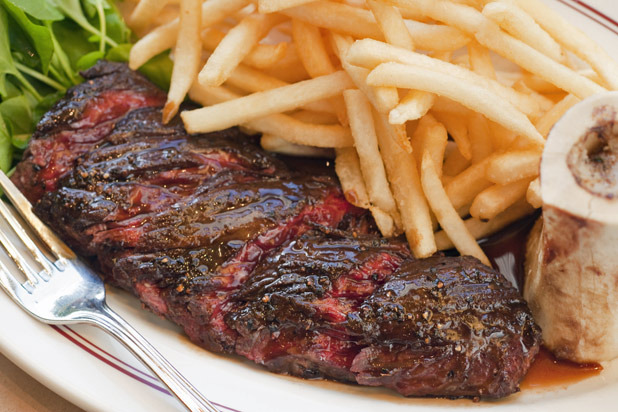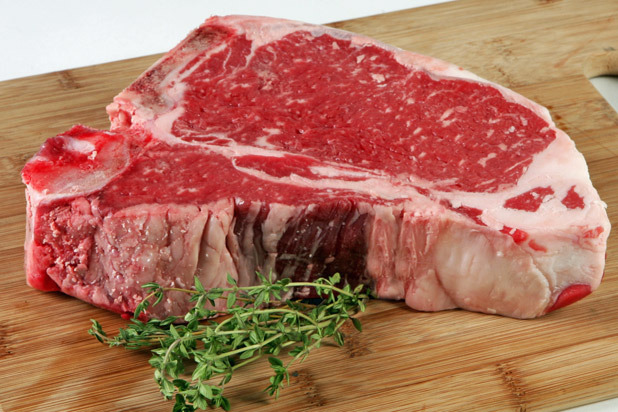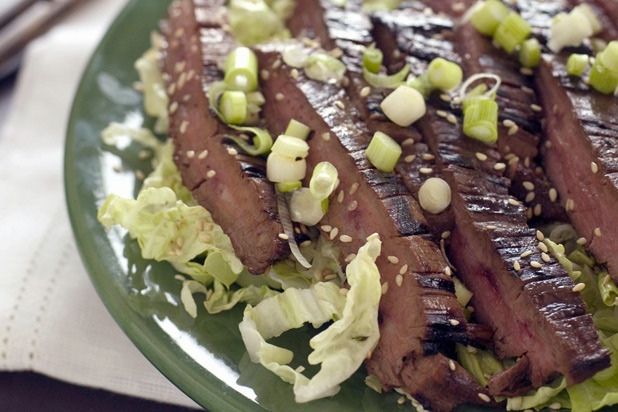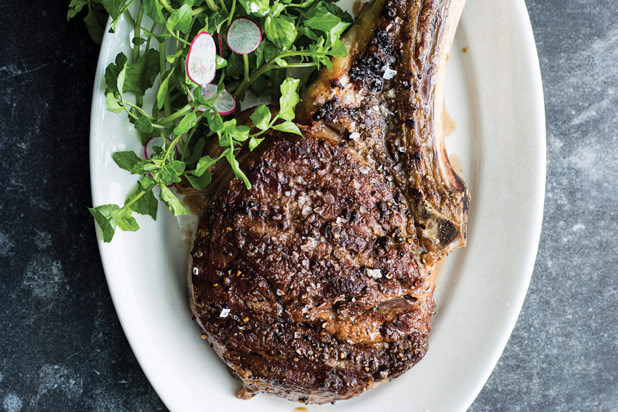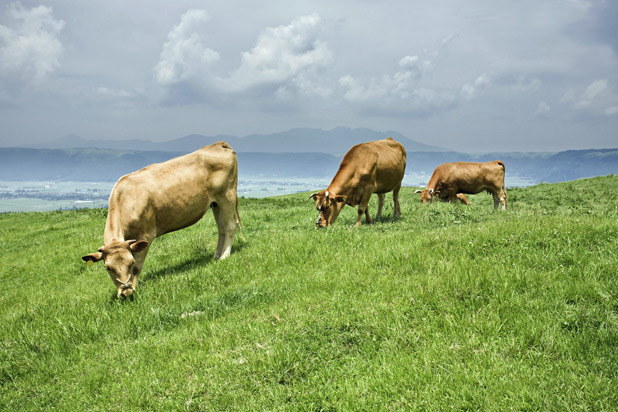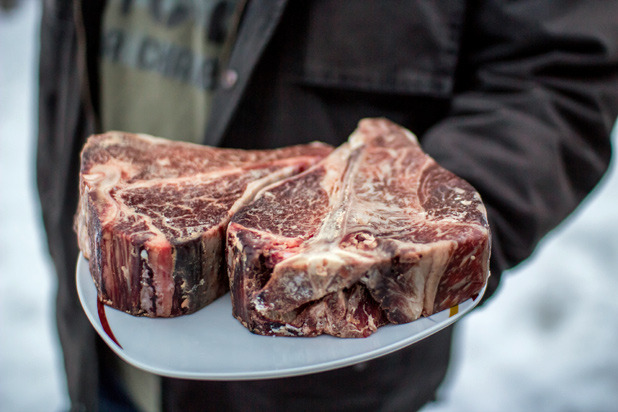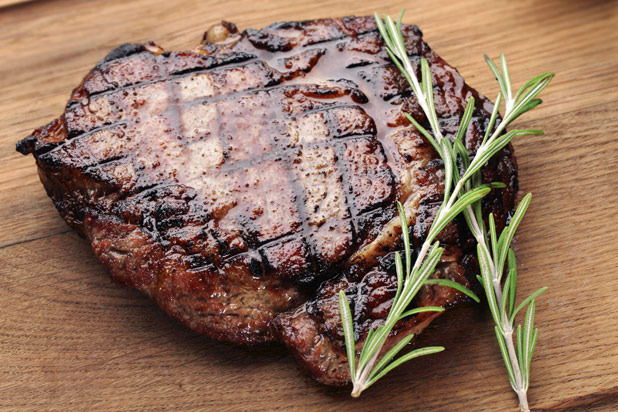A Guide To Steak Cuts Slideshow
This long cut from the underside of the steer is tougher and fattier than most cuts but has a great beefy flavor and is one of the most affordable cuts in the case. Novice grillers listen up — because the cut is long and relatively thin, it's easy to overcook. To get the best results, you need intense heat. Set your grill to blazing hot and sear skirt steak quickly on each side before it has a chance to cook all the way through. You'll end up with a fantastic crust and a tender center for a perfect bite every time.
Tip: Skirt steak is often sold with a tough membrane covering that should be removed before cooking. That's something your butcher can help you with before you leave the store.
Best Bargains: Flat Iron
Flat iron is another must-try for big flavor at bargain prices. Both flat irons and skirt steaks are great with a coffee rub or marinade and sliced over a fresh summer salad. Both the Cedar-Grilled Flat Iron Steaks with Coffee Rub and Southwest Grilled Beef Salad are great recipes to try.
Best Kept Secret: Hanger Steak
Much like the skirt steak, this cut is prized for its full, beefy flavor and affordable price, but it's also one of the least-known cuts. Historically, butchers brought this piece home instead of selling it because it was so flavorful and because shoppers didn't know to ask for it. The hanger is best when marinated and then flash-grilled over high heat to lock in flavor and moisture, but don't overdo it; cook this cut beyond medium and you'll end up with a chewier steak than you bargained for.
The Two-for-One: Porterhouse
The first cut of the short loin, the porterhouse offers two steaks in one — a lean and tender filet mignon and a well-marbled strip on either end of a small T-shaped bone (the more common T-bone cut is located father up the short loin). Porterhouse and T-bones are both fantastic picks for no-fuss grilling. Because they're so tender, there's no need to marinate — just season with a dash of salt and pepper before grilling. For best results, serve it between medium-rare and medium with a side like Grilled Corn on the Cob with Feta and Herbs or Grilled Asparagus Bundles with Dijon-Orange Vinaigrette.
Crowd Pleaser: Tri-Tip Steak
The tri-tip roast or steak is the 1 ½ to 2 ½ pounds at the bottom of the sirloin. We love this steak because it keeps everyone happy. One end can be medium-well, the other medium-rare, so you can offer folks a range of doneness options with one steak. This cut works really well with spice rubs and marinades. To add a lovely caramel flavor, try adding dark sugars like brown sugar, turbinado sugar, or muscovado sugar to marinades like in this Korean-Style Grilled Steak.
Popular Pick: Rib-Eye (Bone-In or Boneless)
This tender cut from the rib section is the granddaddy of grilling steaks. It gets its tender texture and full flavor from fatty marbling. With all of that marbling, there's no need to marinate; just a dash of salt and pepper will do the trick. If you want to add a little twist of flavor, try Tuscan-Style Grilled Steaks with rosemary and olive oil. Some retailers slice the rib-eye too thin, so look for a cut between 1 ½ and 2 inches thick.
Grass-Fed
You may have heard rumors that grass-fed beef is not as tender as grain-fed, but here's the real story — since it's lower in fat, grass-fed beef runs the risk of drying out or becoming overcooked much quicker than grain-fed beef. The key is to keep the meat moist and take the heat down a notch to better control doneness. It's also best to grease your grill with a little oil or cooking spray to compensate for the lower fat content and keep steaks from sticking to the grates. When cooked right, grass-fed steaks deliver a wonderful, intense flavor.
Prime Flavor
When it comes to flavor and tenderness, dry-aged steaks take the crown. The aging process reduces the moisture content and concentrates the robust, meaty flavor. In addition, the natural enzymes in the meat break down the fibers on a microscopic level, making for a very tender finished product.
Tip: Since there's less moisture in dry-aged cuts, they'll cook slightly faster than your typical steak. Have your meat thermometer handy — 130 to 135 degrees for medium-rare, 140 to 145 for medium.
Grilling Tips
When you want tender and juicy meat every time, using the appropriate heat level and cooking time are crucial factors, and each type of cut has its own rules. Here are some key things to remember when cooking your steak:
-Use direct heat.
-Make sure to preheat your grill. You don't want to put meat on a cold grill.
-Use your thermometer. Don't mess around with guessing and constantly cutting into things to see if they are done. Plus, it's really important for food safety.
-Resist the urge to squeeze or press down on your meat! This will result in a tougher, less juicy cut.
Post-Grilling Tips
Many grill masters know the ins and outs of searing the perfect steak, but the post-grilling steps are just as crucial to achieving the best bites.
-Let your steaks rest for 10 minutes before you start slicing. This will help lock the juices into the meat and keep your steak moist and tender.
-Slice it right! If you don't cut your meat properly, you'll be throwing away all that time and effort you put into grilling the perfect steak. Always cut your meat against the grain (opposite the direction of the muscle fibers) to get those moist and tender bites.
Happy grilling!
